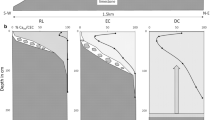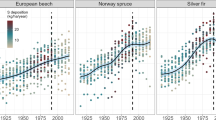Abstract
Ca/Al molar ratios are commonly used to assess the extent of aluminum stress in forests. This is among the first studies to quantify Ca/Al molar ratios for stemflow. Ca/Al molar ratios in bulk precipitation, throughfall, stemflow, litter leachate, near-trunk soil solution, and soil water were quantified for a deciduous forest in northeastern MD, USA. Data were collected over a 3-year period. The Ca/Al molar ratios in this study were above the threshold for aluminum stress (<1). Fagus grandifolia Ehrh. (American beech) had a median annual stemflow Ca/Al molar ratio of 15.7, with the leafed and leafless values of 12.4 and 19.2, respectively. The corresponding Ca/Al molar ratios for Liriodendron tulipifera L. (yellow poplar) were 11.9 at the annual time scale and 11.9 and 13.6 for leafed and leafless periods, respectively. Bayesian statistical analysis showed no significant effect of canopy state (leafed, leafless) on Ca/Al molar ratios. DOC was consistently an important predictor of calcium, aluminum, and Ca/Al ratios. pH was occasionally an important predictor of calcium and aluminum concentrations, but was not a good predictor of Ca/Al ratio in any of the best-fit models (of >500 examined). This study supplies new data on Ca/Al molar ratios for stemflow from two common deciduous tree species. Future work should examine Ca/Al molar ratios in stemflow of other species and examine both inorganic and organic aluminum species to better gauge the potential for, and understand the dynamics of, aluminum toxicity in the proximal area around tree boles.

Similar content being viewed by others
References
Bergkvist, B. (1987). Soil solution chemistry and metal budgets of spruce forest ecosystems in S. Sweden. Water, Air, and Soil Pollution, 33, 131–154.
Binkley, D., & Högberg, P. (1997). Does atmospheric deposition of nitrogen threaten Swedish forests? Forest Ecology and Management, 92, 119–152.
Cronan, C. S. (1980). Soil solution chemistry of a New Hampshire subalpine ecosystem: a biogeochemical analysis. Oikos, 34, 272–281.
Cronan, C. S., & Grigal, D. F. (1995). Use of calcium aluminum ratios as indicators of stress in forest ecosystems. Journal of Environmental Quality, 24, 209–226.
Cronan, C. S., April, R., Bartlett, R. J., Bloom, P. R., Driscoll, C. T., Gherini, S. A., Henderson, G. S., Joslin, J. D., Kelly, J. M., Newton, R. M., Pamell, R. A., Patterson, H. P., Raynal, D. J., Schaedle, M., Schofield, C. L., Sucoff, E. I., Tepper, H. B., & Thornton, F. C. (1989). Aluminum toxicity in forests exposed to acidic deposition: the ALBIOS results. Water, Air, and Soil Pollution, 48, 181–192.
David, M. B., & Driscoll, C. T. (1984). Aluminum speciation and equilibria in soil solutions of a Haplorthod in the Adirondack Mountains (New York). Geoderma, 33, 297–318.
Decker, K. L. M., & Boerner, R. E. J. (1997). Ca/Al ratio effects on growth and competitive interactions of northern red oak (Quercus rubra) and yellow-poplar (Liriodendron tulipifera). Journal of the Torrey Botanical Society, 124, 286–296.
Delhaize, E., & Ryan, P. R. (1995). Aluminum toxicity and tolerance in plants. Plant Physiology, 107, 315–321.
Eisalou, H. K., Sengonul, K., Gokbulak, F., Serengil, Y., & Uygur, B. (2013). Effects of forest canopy cover and floor on chemical quality of water in broad leaved and coniferous forests of Istanbul, Turkey. Forest Ecology and Management, 289, 371–377.
Ellison, A. M. (2004). Bayesian inference in ecology. Ecology Letters, 7, 509–520.
Falkengren-Grerup, U. (1989). Effect of stemflow on beech forest soils and vegetation in southern Sweden. Journal of Applied Ecology, 26, 341–352.
Gelman, A., & Rubin, D. B. (1992). Inference from iterative simulation using multiple sequences (with discussion). Statistical Science, 7, 457–511.
Germer, S., Zimmermann, A., Neill, C., Krusche, A. V., & Elsenbeer, H. (2012). Disproportionate single-species contribution to canopy-soil nutrient flux in an Amazonian rainforest. Forest Ecology and Management, 267, 40–49.
Godbold, D. L., Fritz, E., & Hüttermann, A. (1988). Aluminum toxicity and forest decline. Proceedings of the National Academy of Sciences, 85, 3888–3892.
Göransson, A., & Eldhuset, T. (1991). Effects of aluminum on growth and nutrient uptake of small Picea abies and Pinus sylvestris plants. Trees, 5, 136–142.
Herwitz, S. R. (1986). Episodic stemflow inputs of magnesium and potassium to a tropical forest floor during heavy rainfall events. Oecologia, 70, 423–425.
Jung, K. H., & Chang, S. X. (2013). Soil and tree chemistry reflected the cumulative impact of acid deposition in Pinus banksiana and Populus tremuloides stands in the Athabasca oil sands region in western Canada. Ecological Indicators, 25, 35–44.
Kikuchi, R. (2004). Deacidification effect of the litter layer on forest soil during snowmelt runoff- laboratory experiment and its basic formularization for simulation modeling. Chemosphere, 54, 1163–1169.
Koch, A. S., & Matzner, E. (1993). Heterogeneity of soil and soil solution chemistry under Norway spruce (Picea abies Karst.) and European beech (Fagus sylvatica L.) as influenced by distance from the stem basis. Plant and Soil, 151, 227–237.
Kopacek, J., Cudlin, P., Svoboda, M., Chmelikova, E., Kana, J., & Picek, T. (2010). Composition of Norway spruce litter and foliage in atmospherically acidified and nitrogen-saturated Bohemian Forest stands. Boreal Environment Research, 15, 413–426.
Levia, D. F., & Frost, E. E. (2003). A review and evaluation of stemflow literature in the hydrologic and biogeochemical cycles of forested and agricultural ecosystems. Journal of Hydrology, 274, 1–29.
Levia, D. F., & Frost, E. E. (2006). Variability of throughfall volume and solute inputs in wooded ecosystems. Progress in Physical Geography, 30, 605–632.
Levia, D. F., & Herwitz, S. R. (2000). Physical properties of stemflow water in relation to leachate dynamics: implications for nutrient cycling. Canadian Journal of Forest Research, 30, 662–666.
Levia, D. F., Van Stan, J. T., Siegert, C. M., Inamdar, S. P., Mitchell, M. J., Mage, S. M., & McHale, P. J. (2011). Atmospheric deposition and corresponding variability of stemflow chemistry across temporal scales in a mid-Atlantic broadleaved deciduous forest. Atmospheric Environment, 45, 3046–3054.
Levia, D. F., Michalzik, B., Bischoff, S., Nӓthe, K., Legates, D. R., Gruselle, M. C., & Richter, S. (2013). Measurement and modeling of diameter distributions of particulate matter in terrestrial solutions. Geophysical Research Letters, 40, 1317–1321.
Maryland State Climate Office. (2012). www.atmos.umd.edu/∼climate (retrieved November 2012).
Nakanishi, A., Shibata, H., Inokura, Y., Nakao, T., Toda, H., Sato, F., & Sasa, K. (2001). Chemical characteristics in stemflow of Japanese cedar in Japan. Water, Air, and Soil Pollution, 130, 709–714.
Neary, A. J., & Gizyn, W. I. (1994). Throughfall and stemflow chemistry under deciduous and coniferous forest canopies in south-central Ontario. Canadian Journal of Forest Research, 24, 1089–1100.
Nikodem, A., Kodešová, R., Drábek, O., Bubeníčková, L., Borůvka, L., Pavlů, L., & Tejnecký, V. (2010). A numerical study of the impact of precipitation redistribution in a beech forest canopy on water and aluminum transport in a podzol. Vadose Zone Journal, 9, 238–251.
Pedersen, L. B., & Bille-Hansen, J. (1999). A comparison of litterfall and element fluxes in even aged Norway spruce, Sitka spruce and beech stands in Denmark. Forest Ecology and Management, 114, 55–70.
Plummer, M. (2014). rjags: Bayesian graphical models using MCMC. R package version 3–13. http://CRAN.R-project.org/package=rjags
R Core Team (2014). R: a language and environment for statistical computing. Vienna:R Foundation for Statistical Computing http://www.R-project.org/.
Riha, S. J., Senesac, G., & Pallant, E. (1986). Effects of forest vegetation on spatial variability of surface mineral soil pH, soluble aluminum and carbon. Water, Air, and Soil Pollution, 31, 929–940.
Rustad, L. E., & Cronan, C. S. (1995). Biogeochemical controls on aluminum chemistry in the O horizon of a red spruce (Picea rubens Sarg.) stand in central Maine, USA. Biogeochemistry, 29, 107–129.
Sato, K., & Wakamatsu, T. (2001). Soil solution chemistry in forests with granite bedrock in Japan. Water, Air, and Soil Pollution, 130, 1001–1006.
Schecher, W. D., & Driscoll, C. T. (1987). An evaluation of uncertainty associated with aluminum equilibrium calculations. Water Resources Research, 23, 525–534.
Schildnecht, P. A., & Vidal, B. C. (2002). A role for the cell wall in Al3+ resistance and toxicity: crystallinity and availability of negative charges. International Archives of Biosciences, 1, 1087–1095.
Spiegelhalter, D. J., Best, N. G., Carlin, B. P., & van der Linde, A. (2002). Bayesian measures of model complexity and fit (with discussion). Journal of the Royal Statistical Society, Series B, 64, 583–639.
Sposito, G. (1996). The environmental chemistry of aluminum. Boca Raton:CRC Press 480 p.
Turk, T. (1992). Die wasser- und stoffdynamik in zwei unterschieldlich geschädigten Fichtenstandorten im Fichtelgebirge. Bayreuther Bodenkundl. Berichte, Bd. 22.
Turner, R. S., Johnson, A. H., & Wang, D. (1985). Biogeochemistry of aluminum in McDonald’s Branch watershed, New Jersey Pine Barrens. Journal of Environmental Quality, 14, 314–323.
Van Stan, J. T., Siegert, C. M., Levia, D. F., & Scheick, C. E. (2011). Effects of wind-driven rainfall on stemflow generation between codominant tree species with differing crown characteristics. Agricultural and Forest Meteorology, 151, 1277–1286.
Vanguelova, E. I., Hirano, Y., Eldhuset, T. D., Sas-Paszt, L., Bakker, M. R., Püttsepp, Ü., Brunner, I., Lõhmus, K., & Godbold, D. (2007). Tree fine root Ca/Al molar ratio—indicator of Al and acidity stress. Plant Biosystems, 141, 460–480.
Weathers, K. C., & Ponette-Gonzalez, A. G. (2011). Atmospheric deposition. In D. F. Levia, D. E. Carlyle-Moses, & T. Tanaka (Eds.), Forest hydrology and biogeochemistry: synthesis of past directions and future research (pp. 357–370), Ecological Studies Series No. 216. Heidelberg: Springer.
Acknowledgments
The US National Science Foundation is formally and gratefully acknowledged for two grant awards that made this work possible (EAR-0809205 and BCS-1003047). Dr. Carl Rosier is thanked for his assistance with the quantification of the chemical properties of near-trunk soils. The administration, staff, and volunteers at the Fair Hill Natural Resource Management Area are thanked for site access, site security, and interest in our research.
Author information
Authors and Affiliations
Corresponding author
Rights and permissions
About this article
Cite this article
Levia, D.F., Shiklomanov, A.N., Van Stan, J.T. et al. Calcium and aluminum cycling in a temperate broadleaved deciduous forest of the eastern USA: relative impacts of tree species, canopy state, and flux type. Environ Monit Assess 187, 458 (2015). https://doi.org/10.1007/s10661-015-4675-3
Received:
Accepted:
Published:
DOI: https://doi.org/10.1007/s10661-015-4675-3




